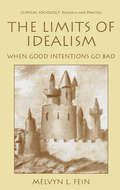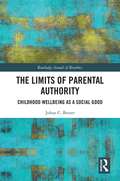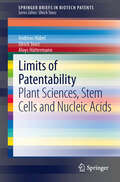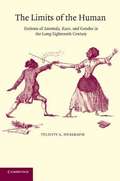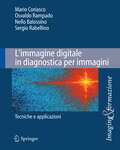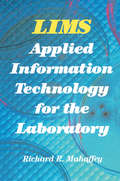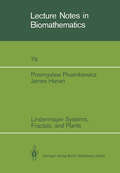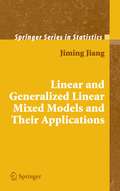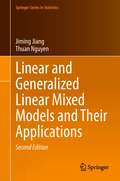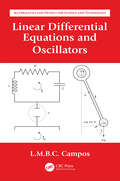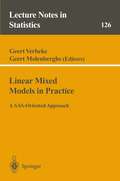- Table View
- List View
The Limits of Dream: A Scientific Exploration of the Mind / Brain Interface
by J. F. PagelThe Limits of Dream focuses on what we currently know of the human central nervous system (CNS), examining the basic sciences of neurochemisty, neuroanatomy, and CNS electrophysiology as these sciences apply to dream, then reaching beyond basic science to examine the cognitive science of dreaming including the processes of memory, the perceptual interface, and visual imagery. Building on what is known of intrapersonal CNS processing, the book steps outside the physical body to explore artificially created dreams and their use in filmmaking, art and story, as well as the role of dreaming in creative process and creative "madness. The limits of our scientific knowledge of dream frame this window that can be used to explore the border between body and mind. What is known scientifically of the cognitive process of dreaming will lead the neuroscientist, the student of cognitive science, and the general reader down different paths than expected into an exploration of the fuzzy and complex horizon between mind and brain. - The clearest presentation of research and philosophy currently available relating to the mind/brain interface - Discusses the cognitive processes of dreaming utilized in film and artificial intelligence - Describes the functioning of dream in the creative process
The Limits of Idealism: When Good Intentions Go Bad (Clinical Sociology: Research and Practice)
by Melvyn L. FeinIf the truth be known, I am only a partially reformed idealist. In the secret depths of my soul, I still wish to make the world a better place and sometimes fantasize about heroically eradicating its faults. When I encounter its limitations, it is consequently with deep regret and continued surprise. How, I ask myself, is it possible that that which seems so fight can be a chimera? And why, I wonder, aren't people as courageous, smart, or nice as I would like? The pain of realizing these things is sometimes so intense that I want to close my eyes and lose myself in the kinds of daydreams that comforted me as a youngster. One thing is clear, my need to come to grips with my idealism had its origin in a lifetime of naivet6. From the beginning, I wanted to be a "good" person. Often when life was most treacherous, I retreated into a comer from whence I escaped into reveries of moral glory. When I was very young, my faith was in religion. In Hebrew school, I took my lessons seriously and tried to apply them at home. By my teen years, this had been replaced by an allegiance to socialism. In the Brooklyn where I grew up, my teachers and relatives made this seem the natural course. When I reached my twenties, however, and was obliged to confront a series of personal deficiencies, psychotherapy shouldered its way to the fore.
The Limits of Parental Authority: Childhood Wellbeing as a Social Good (Routledge Annals of Bioethics)
by Johan C. BesterThis book offers a novel theory of childhood well-being as a social good. It re-examines our fundamental assumptions about parenting, parental authority, and a liberal society’s role in the raising of children. The author defends the idea that the good of a child is inexorably linked to the good of society. He identifies and critiques the problematic assumption that parenting is an extension of individual liberty and shows how we run into problems in medical decision-making for children because of this assumption. He develops an objective conception of what is good for a child in a liberal society, drawing on the assumptions of liberty, and from here constructs a set of things that society and its members owe children. There are ways in which society should support and intervene in parental decisions to guarantee a child’s well-being. Ultimately, raising children is a social activity that requires input from society. The author then applies this theory of childhood well-being to develop a framework for medical decision-making for children. He also uses practical examples, such as vaccinations, parental leave, and healthcare access, to demonstrate the implications of his theory for public policy. The Limits of Parental Authority: Childhood Wellbeing as a Social Good will be of interest to practitioners, scholars, and advanced students working in bioethics, political philosophy, and public health policy.
The Limits of Parental Authority: Childhood Wellbeing as a Social Good (Routledge Annals of Bioethics)
by Johan C. BesterThis book offers a novel theory of childhood well-being as a social good. It re-examines our fundamental assumptions about parenting, parental authority, and a liberal society’s role in the raising of children. The author defends the idea that the good of a child is inexorably linked to the good of society. He identifies and critiques the problematic assumption that parenting is an extension of individual liberty and shows how we run into problems in medical decision-making for children because of this assumption. He develops an objective conception of what is good for a child in a liberal society, drawing on the assumptions of liberty, and from here constructs a set of things that society and its members owe children. There are ways in which society should support and intervene in parental decisions to guarantee a child’s well-being. Ultimately, raising children is a social activity that requires input from society. The author then applies this theory of childhood well-being to develop a framework for medical decision-making for children. He also uses practical examples, such as vaccinations, parental leave, and healthcare access, to demonstrate the implications of his theory for public policy. The Limits of Parental Authority: Childhood Wellbeing as a Social Good will be of interest to practitioners, scholars, and advanced students working in bioethics, political philosophy, and public health policy.
Limits of Patentability: Plant Sciences, Stem Cells and Nucleic Acids (SpringerBriefs in Biotech Patents)
by Andreas Hübel Ulrich Storz Aloys HüttermannSpringerBriefs in Biotech Patents presents timely reports on intellectual properties (IP) issues and patent aspects in the field of biotechnology. In this volume the limits of patentability are addressed, a question that is often raised when it comes to biotechnological inventions: The first section addresses current issues in the patentability of plants produced by essentially biological processes including the controversy between farmer’s privilege and patent exhaustion with respect to seeds in the US. The second section examines the patentability of human embryonic stem cells in Europe and the US, also considering alternative technologies with respect to their practicability and patentability. The third section focuses on the patentability of genes and nucleic acids, especially the issue of patenting of encoding genes and nucleic acids.
The Limits Of The Human: Fictions Of Anomaly, Race and Gender in the Long Eighteenth Century (PDF)
by Felicity A. NussbaumIn this book, Felicity Nussbaum examines literary and cultural representations of human difference in England and its empire during the long eighteenth century. With a special focus on women's writing, Nussbaum analyzes canonical and lesser-known novels and plays from the Restoration to abolition. She considers a range of anomalies (defects, disease, and disability) as they intermingle with ideas of femininity, masculinity, and race to define 'normalcy' as national identity. Incorporating writings by Behn, Burney, and the Bluestockings, as well as Southerne, Shaftesbury, Johnson, Sterne, and Equiano, Nussbaum treats a range of disabilities - being mute, blind, lame - and physical oddities such as eunuchism and giantism as they are inflected by emerging notions of a racial femininity and masculinity. She shows that these corporeal features, perceived as aberrant and extraordinary, combine in the popular imagination to reveal a repertory of differences located between the extremes of splendid and horrid novelty.
Limits to Medicine: Medical Nemesis: The Expropriation of Health (Pelican Ser.)
by Ivan IllichThe medical establishment has become a major threat to health'. So begins Ivan Illich's spirited and reasoned attack upon the mythic prestige of contemporary medicines, examining the customs and rituals conducted by the medical profession. Relentlessly and with full documentation taken from recognized medical sources Illich proves the impotence of medical services to change life expectancy, the insignificance of most clinical care in curing disease, the magnitude of medically inflicted damage to health, and the futility of medical and political counter measures.
L'immagine digitale in diagnostica per immagini: Tecniche e applicazioni (Imaging & Formazione)
by Mario Coriasco Osvaldo Rampado Nello Balossino Sergio RabellinoIl volume illustra i fondamenti necessari per acquisire, elaborare e valutare le immagini radiologiche con un approccio interdisciplinare, che coniuga contributi di fisica, informatica biomedica e radiologia. Dopo un’introduzione al trattamento digitale di segnali e alla psicofisiologia della visione, vengono descritti i parametri caratteristici e gli indicatori di qualità delle immagini digitali, passando poi alle principali tecniche di elaborazione delle immagini, sia nel dominio spaziale sia in quello delle frequenze.Sono trattati gli algoritmi per il filtraggio, le tecniche di segmentazione, con dettaglio specifico per le diverse metodiche di imaging, concludendo con una rassegna dei principali formati di memorizzazione tra cui lo standard più diffuso per le immagini ad uso medico, il DICOM.Il testo è corredato da schede di autovalutazione ed esercizi che permettono di verificare il proprio livello di apprendimento dei concetti affrontati. Inoltre, a complemento dell'opera, il lettore potrà accedere, tramite un software gratuito, a un vero e proprio laboratorio di elaborazione di immagini con il quale potrà esercitarsi a riprodurre personalmente gli esempi di elaborazione illustrati.Il volume rappresenta dunque un utile riferimento per i docenti e gli studenti che affrontino la materia, ma il taglio pratico e accessibile lo rende anche un valido strumento di consultazione per tecnici radiologi, specializzandi e medici e tutti coloro che desiderino approfondire le elaborazioni che coinvolgono la diagnostica per immagini.
LIMS: Applied Information Technology for the Laboratory
by Richard MahaffeyComputing and information management technologies touch our lives in the environments where we live, play and, work. High tech is becoming the standard. Those of use who work in a laboratory environment are faced with an obvious challenge. How do we best apply these technol ogies to make money for our companies? The first level of deliverable benefits is achieved through task automation. The second level is ob tained by integrating the individual islands of automation. The third, or top level, of benefits is related to applying intelligence to computing applications. The use of computing technology, at level one, to automate lab pro cedures, methods, and instruments has been profitable for many years. We can easily find yearly returns in the range of 10-50% for investments at this level. For level two, the integration of some applications has evolved and has led to data management systems and local area net working in the lab environment. Investment paybacks at level two are substantially higher, in the range of 200-400%. Examples of applications at the top level, that of intelligent systems and applications, are few and far between. And what about the payback for investments at this level? With such limited experience at level three, we can only estimate the benefits. But again, they appear to be much higher, in the range of 2000- 4000%.
Linac Radiosurgery: A Practical Guide
by William A. Friedman John M. Buatti Francis J. Bova William M. MendenhallDesigned as a practical guide to linac radiosurgery, the book addresses the pertinent aspects of stereotactic treatment delivery. In recent years, there has been a massive increase in the use of this method rather than gamma knife or particle beam technology, and this book provides a hands-on guide to the methods and treatment delivery implemented by leading authorities at the University of Florida.
Lindenmayer Systems, Fractals, and Plants (Lecture Notes in Biomathematics #79)
by Przemyslaw Prusinkiewicz James Hanan1-systems are a mathematical formalism which was proposed by Aristid 1indenmayer in 1968 as a foundation for an axiomatic theory of develop ment. The notion promptly attracted the attention of computer scientists, who investigated 1-systems from the viewpoint of formal language theory. This theoretical line of research was pursued very actively in the seventies, resulting in over one thousand publications. A different research direction was taken in 1984 by Alvy Ray Smith, who proposed 1-systems as a tool for synthesizing realistic images of plants and pointed out the relationship between 1-systems and the concept of fractals introduced by Benoit Mandel brot. The work by Smith inspired our studies of the application of 1-systems to computer graphics. Originally, we were interested in two problems: • Can 1-systems be used as a realistic model of plant species found in nature? • Can 1-systems be applied to generate images of a wide class of fractals? It turned out that both questions had affirmative answers. Subsequently we found that 1-systems could be applied to other areas, such as the generation of tilings, reproduction of a geometric art form from East India, and synthesis of musical scores based on an interpretation of fractals. This book collects our results related to the graphical applications of- systems. It is a corrected version of the notes which we prepared for the ACM SIGGRAPH '88 course on fractals.
Lindhe's Clinical Periodontology and Implant Dentistry
by Niklaus P. Lang William V. Giannobile Tord Berglundh Mariano SanzDiscover the latest edition of the cornerstone reference on periodontology and implant dentistry that combines scholarship and science with practical clinical instruction The Seventh Edition of Lindhe's Clinical Periodontology and Implant Dentistry brings together a distinguished team of periodontal specialists and academics who deliver another must-have resource for students, researchers, and practitioners specializing in periodontal care and implant dentistry. Seamlessly integrating the foundational science behind periodontology with practical clinical protocols in two comprehensive volumes, the chapters cover anatomy, microbiology, occlusion trauma, pathology, tissue regeneration, treatment planning protocols, infection control, reconstructive therapy, occlusal and prosthetic therapy, and more. The Seventh Edition of Lindhe's Clinical Periodontology and Implant Dentistry: Provides an introduction to anatomy, including periodontal tissues, the edentulous ridge, the mucosa at teeth and implants, and osseointegration Discusses the epidemiology of periodontal and peri-implant diseases Explores the microbiology, including dental biofilms and calculus, periodontal infections, peri-implant infections, the pathogenesis of gingivitis and periodontitis, and the genetic susceptibility to periodontal disease Includes the latest perio- and peri-implant disease classifications Contains updated evidence-based preventive and treatment modalities for the treatment of periodontal and peri-implant diseases Features the latest evidence-based therapeutic alternatives on the use of dental implants to rehabilitate the lost dentition Perfect for postgraduate dental students, researchers, and practitioners specializing in periodontal care and implant dentistry, Lindhe's Clinical Periodontology and Implant Dentistry continues to be the cornerstone reference work on periodontology.
Lindhe's Clinical Periodontology and Implant Dentistry
by Niklaus P. Lang William V. Giannobile Tord Berglundh Mariano SanzDiscover the latest edition of the cornerstone reference on periodontology and implant dentistry that combines scholarship and science with practical clinical instruction The Seventh Edition of Lindhe's Clinical Periodontology and Implant Dentistry brings together a distinguished team of periodontal specialists and academics who deliver another must-have resource for students, researchers, and practitioners specializing in periodontal care and implant dentistry. Seamlessly integrating the foundational science behind periodontology with practical clinical protocols in two comprehensive volumes, the chapters cover anatomy, microbiology, occlusion trauma, pathology, tissue regeneration, treatment planning protocols, infection control, reconstructive therapy, occlusal and prosthetic therapy, and more. The Seventh Edition of Lindhe's Clinical Periodontology and Implant Dentistry: Provides an introduction to anatomy, including periodontal tissues, the edentulous ridge, the mucosa at teeth and implants, and osseointegration Discusses the epidemiology of periodontal and peri-implant diseases Explores the microbiology, including dental biofilms and calculus, periodontal infections, peri-implant infections, the pathogenesis of gingivitis and periodontitis, and the genetic susceptibility to periodontal disease Includes the latest perio- and peri-implant disease classifications Contains updated evidence-based preventive and treatment modalities for the treatment of periodontal and peri-implant diseases Features the latest evidence-based therapeutic alternatives on the use of dental implants to rehabilitate the lost dentition Perfect for postgraduate dental students, researchers, and practitioners specializing in periodontal care and implant dentistry, Lindhe's Clinical Periodontology and Implant Dentistry continues to be the cornerstone reference work on periodontology.
Linear and Generalized Linear Mixed Models and Their Applications (Springer Series in Statistics)
by Jiming JiangThis book covers two major classes of mixed effects models, linear mixed models and generalized linear mixed models. It presents an up-to-date account of theory and methods in analysis of these models as well as their applications in various fields. The book offers a systematic approach to inference about non-Gaussian linear mixed models. Furthermore, it includes recently developed methods, such as mixed model diagnostics, mixed model selection, and jackknife method in the context of mixed models. The book is aimed at students, researchers and other practitioners who are interested in using mixed models for statistical data analysis.
Linear and Generalized Linear Mixed Models and Their Applications (Springer Series in Statistics)
by Jiming Jiang Thuan NguyenThis book covers two major classes of mixed effects models, linear mixed models and generalized linear mixed models. It presents an up-to-date account of theory and methods in analysis of these models as well as their applications in various fields. The book offers a systematic approach to inference about non-Gaussian linear mixed models. Furthermore, it includes recently developed methods, such as mixed model diagnostics, mixed model selection, and jackknife method in the context of mixed models. The book is aimed at students, researchers and other practitioners who are interested in using mixed models for statistical data analysis.
Linear Differential Equations and Oscillators (Mathematics and Physics for Science and Technology)
by Luis Manuel Braga da Costa CamposLinear Differential Equations and Oscillators is the first book within Ordinary Differential Equations with Applications to Trajectories and Vibrations, Six-volume Set. As a set, they are the fourth volume in the series Mathematics and Physics Applied to Science and Technology. This first book consists of chapters 1 and 2 of the fourth volume. The first chapter covers linear differential equations of any order whose unforced solution can be obtained from the roots of a characteristic polynomial, namely those: (i) with constant coefficients; (ii) with homogeneous power coefficients with the exponent equal to the order of derivation. The method of characteristic polynomials is also applied to (iii) linear finite difference equations of any order with constant coefficients. The unforced and forced solutions of (i,ii,iii) are examples of some general properties of ordinary differential equations. The second chapter applies the theory of the first chapter to linear second-order oscillators with one degree-of-freedom, such as the mechanical mass-damper-spring-force system and the electrical self-resistor-capacitor-battery circuit. In both cases are treated free undamped, damped, and amplified oscillations; also forced oscillations including beats, resonance, discrete and continuous spectra, and impulsive inputs. Describes general properties of differential and finite difference equations, with focus on linear equations and constant and some power coefficients Presents particular and general solutions for all cases of differential and finite difference equations Provides complete solutions for many cases of forcing including resonant cases Discusses applications to linear second-order mechanical and electrical oscillators with damping Provides solutions with forcing including resonance using the characteristic polynomial, Green' s functions, trigonometrical series, Fourier integrals and Laplace transforms
Linear Differential Equations and Oscillators (Mathematics and Physics for Science and Technology)
by Luis Manuel Braga da Costa CamposLinear Differential Equations and Oscillators is the first book within Ordinary Differential Equations with Applications to Trajectories and Vibrations, Six-volume Set. As a set, they are the fourth volume in the series Mathematics and Physics Applied to Science and Technology. This first book consists of chapters 1 and 2 of the fourth volume. The first chapter covers linear differential equations of any order whose unforced solution can be obtained from the roots of a characteristic polynomial, namely those: (i) with constant coefficients; (ii) with homogeneous power coefficients with the exponent equal to the order of derivation. The method of characteristic polynomials is also applied to (iii) linear finite difference equations of any order with constant coefficients. The unforced and forced solutions of (i,ii,iii) are examples of some general properties of ordinary differential equations. The second chapter applies the theory of the first chapter to linear second-order oscillators with one degree-of-freedom, such as the mechanical mass-damper-spring-force system and the electrical self-resistor-capacitor-battery circuit. In both cases are treated free undamped, damped, and amplified oscillations; also forced oscillations including beats, resonance, discrete and continuous spectra, and impulsive inputs. Describes general properties of differential and finite difference equations, with focus on linear equations and constant and some power coefficients Presents particular and general solutions for all cases of differential and finite difference equations Provides complete solutions for many cases of forcing including resonant cases Discusses applications to linear second-order mechanical and electrical oscillators with damping Provides solutions with forcing including resonance using the characteristic polynomial, Green' s functions, trigonometrical series, Fourier integrals and Laplace transforms
Linear Mixed Models in Practice: A SAS-Oriented Approach (Lecture Notes in Statistics #126)
by Geert Verbeke Geert MolenberghsA comprehensive treatment of linear mixed models, focusing on examples from designed experiments and longitudinal studies. Aimed at applied statisticians and biomedical researchers in industry, public health organisations, contract research organisations, and academia, this book is explanatory rather than mathematical rigorous. Although most analyses were done with the MIXED procedure of the SAS software package, and many of its features are clearly elucidated, considerable effort was put into presenting the data analyses in a software-independent fashion.
Lineare Algebra (Springer-Lehrbuch)
by Klaus Jänich"Daß ein Einführungstext zur Linearen Algebra bei der ständig wachsenden Flut von Lehrbüchern zu diesem weitgehend standardisierten Stoff überhaupt noch Besonderheiten bieten kann, ist gewiß bemerkenswert. Um so erstaunlicher, daß die hier schon beim ersten Durchblättern ins Auge springen... (Sie liegen in dem) im Kleindruck beigegebenen "Nebentext", in dem der Autor neben Beweisdetails vor allem "Erläuterungen, Motivation, gutes Zureden ", historische Hinweise und Aufmunterungen zum Lesen anderer Literatur untergebracht hat... Es wird all das Mehr wiedergegeben, das eine gute Vorlesung gegenüber einem Lehrbuch im üblichen Stil (Definition - Satz - Beweis - Beispiel) auszeichnet. Ein anderes charakteristisches Merkmal des Buches besteht in der Unterteilung in einen Kerntext, der die wichtigsten Sätze der Theorie enthält, und in Ergänzungen für Mathematiker und für Physiker. Am Ende jedes Paragraphen werden dem Erstsemesterstudenten neben Übungsmaterial auch einfache Testfragen angeboten, an denen er sein Verständnis erproben kann." Mathematisch-Physikalische-Semesterberichte
Lineare Algebra (Springer-Lehrbuch)
by Klaus JänichJetzt in der 9. Auflage besticht dieses Buch besonders durch seine Testfragen am Ende. Zur Vorbereitung auf die Zwischenprüfung bestens geeignet.Aus den Besprechungen: "Dieses Buch ist als ein wirkliches "Lernbuch" konzipiert: Nach der Behandlung der Grundlagen werden dem Leser Tests angeboten, deren richtige Bearbeitung er kontrollieren kann; die nachfolgenden Ergänzungen sollte er aber erst dann durcharbeiten, wenn der jeweilige Test bestanden ist. Diese Ergänzungen richten sich differenziert an Mathematiker oder Physiker, dasselbe gilt für die Übungsaufgaben..."Der Mathematische und Naturwissenschaftliche Unterricht
Lineare Algebra (Springer-Lehrbuch)
by Klaus JänichHier im Hause habe ich vor allem Frau Hertl zu danken, die das 'IEX-Skript geschrieben hat und Herrn Michael Prechtel, der zur Lösung schwieriger 1EX Probleme so manche Stunde für uns abgezweigt hat. Auch Frau Zirngibl danke ich für Ihre Mithilfe bei der Vorbereitung des Manuskripts. Kurz vor Ablauf des Termins schließlich, wenn sich der Fleiß zur Hektik steigert, hätte ich ohne den Einsatz meiner Mitarbeiter Martin Lercher und Robert Mandl wie ein Formel-I-Fahrer dagestanden, der während des Rennens seine Reifen selber wechseln soll. Ihnen allen sei herzlich gedankt. Regensburg, im August 1991 Klaus J änich Inhaltsverzeichnis 1. Mengen und Abbildungen 1. 1 Mengen . . . . . . . . . . . . . . . . . . . . . . . . . . . . . . . . . . . . . . . . . . . . . . . . . . . . . . . 1 1. 2 Abbildungen . . . . . . . . . . . . . . . . . . . . . . . . . . . . . . . . . . . . . . . . . . . . . . . . . . 8 1. 3 Test . . . . . . . . . . . . . . . . . . . . . . . . . . . . . . . . . . . . . . . . . . . . . . . . . . . . . . . . . 14 1. 4 Literaturhinweis . . . . . . . . . . . . . . . . . . . . . . . . . . . . . . . . . . . . . . . . . . . . . 16 1. 5 Übungen . . . . . . . . . . . . . . . . . . . . . . . . . . . . . . . . . . . . . . . . . . . . . . . . . . . . 18 2. Vektorräume 2. 1 Reelle Vektorräume . . . . . . . . . . . . . . . . . . . . . . . . . . . . . . . . . . . . . . . . . . 20 2. 2 Komplexe Zahlen und Komplexe Vektorräume . . . . . . . . . . . . . . . . 26 2. 3 Untervektorräume . . . . . . . . . . . . . . . . . . . . . . . . . . . . . . . . . . . . . . . . . . . 30 2. 4 Test . . . . . . . . . . . . . . . . . . . . . . . . . . . . . . . . . . . . . . . . . . . . . . . . . . . . . . . . . 33 2. 5 Körper (Ein Abschnitt für Mathematiker) . . . . . . . . . . . . . . . . . . . . 34 2. 6 Was sind Vektoren? (Ein Abschnitt für Physiker) . . . . . . . . . . . . 38 2. 7 Komplexe Zahlen vor 400 Jahren (Historische Notiz) . . . . . . . . . 50 2. 8 Literaturhinweis . . . . . . . . . . . . . . . . . . . . . . . . . . . . . . . . . . . . . . . . . . . . . 51 2. 9 Übungen . . . . . . . . . . . . . . . . . . . . . . . . . . . . . . . . . . . . . . . . . . . . . . . . . . . . 52 3. Dimensionen 3. 1 Lineare Unabhängigkeit . . . . . . . . . . . . . . . . . . . . . . . . . . . . . . . . . . . . . . 56 3. 2 Der Dimensionsbegriff . . . . . . . . . . . . . . . . . . . . . . . . . . . . . . . . . . . . . . . 59 3. 3 Test . . . . . . . . . . . . . . . . . . . . . . . . . . . . . . . . . . . . . . . . . . . . . . . . . . . . . . . . . 64 3. 4 Beweis des Basisergänzungssatzes und des Austaus- lemmas (Ein Abschnitt für Mathematiker) . . . . . . . . . . . . . . . . . . . 66 3. 5 Das Vektorprodukt (Ein Abschnitt für Physiker) . . . . . . . . . . . . . 69 3. 6 Der "Steinitzsche Austauschsatz" (Historische Notiz) . . . . . . . . 75 3. 7 Literaturhinweis . . . . . . . . . . . . . . . . . . . . . . . . . . . . . . . . . . . . . . . . . . . . . 77 3. 8 Übungen . . . . . . . . . . . . . . . . . . . . . . . . . . . . . . . . . . . . . . . . . . . . . . . . . . . . 77 VIII INHALTSVERZEICHNIS 4. Lineare Abbildungen 4. 1 Lineare Abbildungen . . . . . . . . . . . . . . . . . . . . . . . . . . . . . . . . . . . . . . . . . 80 4. 2 Matrizen . . . . . . . . . . . . . . . . . . . . . . . . . . . . . . . . . . . . . . . . . . . . . . . . . . . .
Lineare Algebra (Springer-Lehrbuch)
by Klaus Jänich"Daß ein Einführungstext zur Linearen Algebra bei der ständig wachsenden Flut von Lehrbüchern zu diesem weitgehend standardisierten Stoff überhaupt noch Besonderheiten bieten kann, ist gewiß bemerkenswert. Um so erstaunlicher, daß die hier schon beim ersten Durchblättern ins Auge springen... (Sie liegen in dem) im Kleindruck beigegebenen "Nebentext", in dem der Autor neben Beweisdetails vor allem "Erläuterungen, Motivation, gutes Zureden ", historische Hinweise und Aufmunterungen zum Lesen anderer Literatur untergebracht hat... Es wird all das Mehr wiedergegeben, das eine gute Vorlesung gegenüber einem Lehrbuch im üblichen Stil (Definition - Satz - Beweis - Beispiel) auszeichnet. Ein anderes charakteristisches Merkmal des Buches besteht in der Unterteilung in einen Kerntext, der die wichtigsten Sätze der Theorie enthält, und in Ergänzungen für Mathematiker und für Physiker. Am Ende jedes Paragraphen werden dem Erstsemesterstudenten neben Übungsmaterial auch einfache Testfragen angeboten, an denen er sein Verständnis erproben kann." Mathematisch-Physikalische-Semesterberichte
Linguistic Analyses of Aphasic Language (Springer Series in Neuropsychology)
by Jacqueline A. Stark Wolfgang U. DresslerLinguistic Analyses of Aphasic Language represents results from linguistic and neurolinguistic research on aphasic language performance. The contributions encompass all linguistic levels, ranging from phonetics to discourse, and present results on languages other than English. The findings and applied methods are both relevant to the study of aphasia in general and to cross-linguistic analyses. Furthermore, they have clear implications for language and speech therapy and thus show the importance of linguistic concepts for language testing and therapeutic intervention.
The Linguistic Cerebellum
by Peter Mariën Mario MantoThe Linguistic Cerebellum provides a comprehensive analysis of this unique part of the brain that has the most number of neurons, each operating in distinct networks to perform diverse functions. This book outlines how those distinct networks operate in relation to non-motor language skills. Coverage includes cerebellar anatomy and function in relation to speech perception, speech planning, verbal fluency, grammar processing, and reading and writing, along with a discussion of language disorders. - Discusses the neurobiology of cerebellar language functions, encompassing both normal language function and language disorders - Includes speech perception, processing, and planning - Contains cerebellar function in reading and writing - Explores how language networks give insight to function elsewhere in the brain
Linguistics For Clinicians
by Maria Black Shula ChiatLinguistics for Clinicians provides an introduction to linguistic analysis in the clinical context. The book draws on a range of linguistic theories and descriptions, equipping readers with a conceptual toolkit that will enable them to: analyse data systematically, taking into account different types of linguistic properties; pick out significant patterns that can give them clinically relevant cues; build explicit arguments to back up their observations and hypotheses; select relevant linguistic items for assessment and therapy tasks. The syntactic sections cover standard concepts and their application to a range of data is worked through step by step. This solid grounding in syntax provides a springboard for detailed analyses of sentence semantics and sentence phonology which are particularly relevant in clinical assessment and therapy, but are not usually available outside specialist linguistic texts. These sections cover: event structure and its representation by verbs and their complements; the timing and modality of events and their representation by the auxiliary system; rhythmic patterns of sentences and how the type and position of individual words influences them. Clinical relevance is a central theme throughout the book. All linguistic concepts are introduced with examples of their clinical use. Analytical tips are included to anticipate and deal with common problems of clinical application. Extensive exercises further illustrate the use of linguistic concepts in data analysis and task construction. Linguistics for Clinicians is primarily a linguistics textbook for students and teachers on clinical courses. It is also a useful resource for practicing clinicians, psycholinguitics students and researchers in language impairments. 9780340758953

